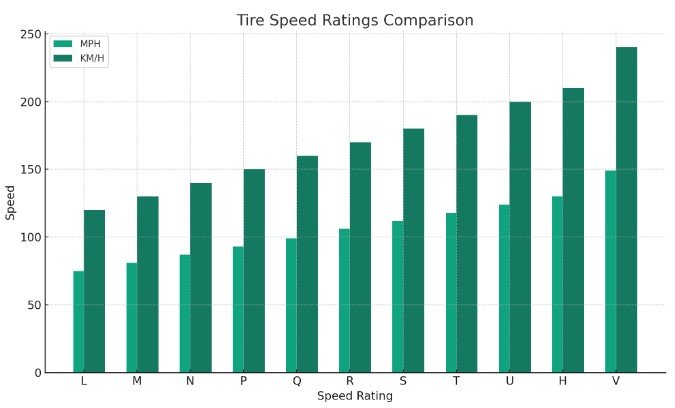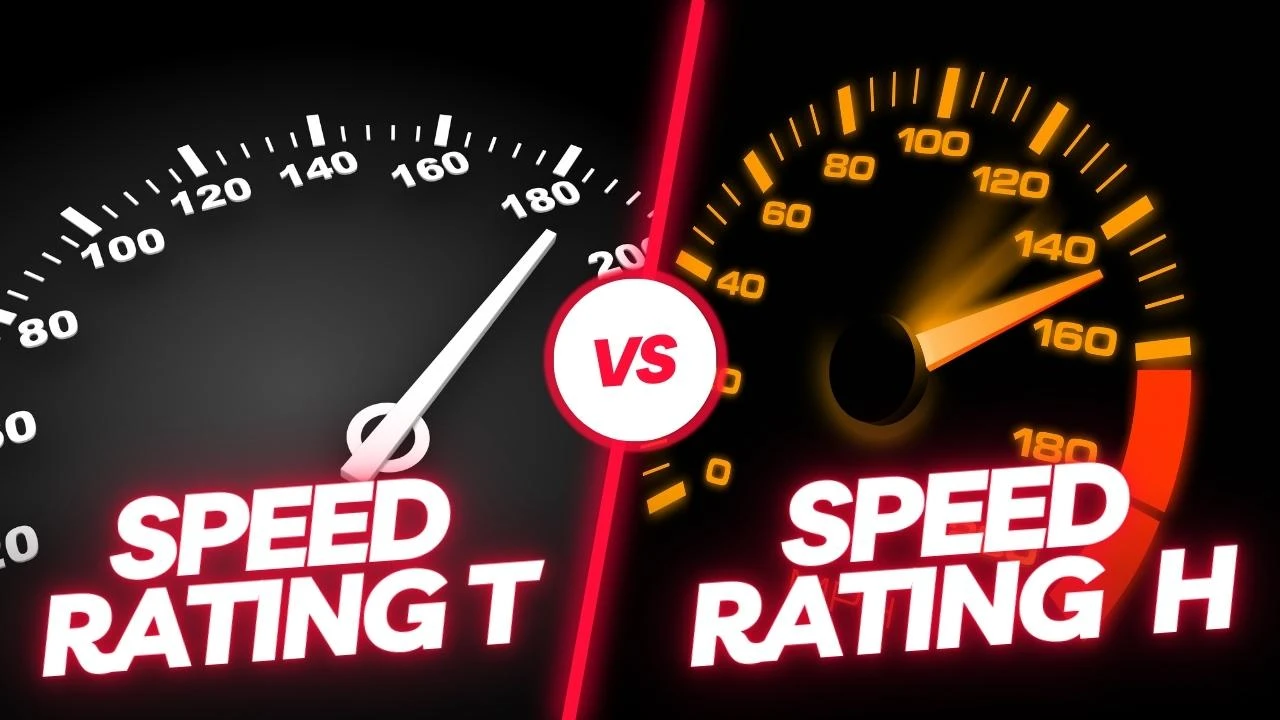When it comes to safety and performance on the road, the details matter—especially those embedded in the sidewall of your tires.
Speed ratings like T and H might not mean much at a glance, but they’re crucial when it’s your vehicle cruising down the highway. It’s the difference between a tire that can confidently handle the autobahn’s demands and one that’s better suited for a leisurely Sunday drive.
H-rated tires can reach speeds of up to 130 mph, while T-rated tires can reach speeds of up to 118 mph.
This isn’t just about pushing speed limits; it’s about matching your tire to your driving style. Like choosing the right pair of shoes for a marathon, selecting a tire with the appropriate speed rating is about finding the perfect fit for your car’s capabilities and your driving needs.
With the right knowledge, you can turn a mundane purchase into a pivotal decision for your vehicle’s performance and longevity.
Understanding Tire Speed Ratings

Tire speed ratings are essentially the maximum speed that a tire is certified to be driven safely. They serve as the tire’s “speed limit.” These ratings ensure that your tires can handle the heat and stress of high speeds without failing.
What Are Tire Speed Ratings?
Speed ratings are not just random letters; they’re carefully tested indicators of a tire’s capability. They’re like the grades you get in school, but for how fast your tires can go without getting into trouble. Each letter represents a top speed your tire can handle. It’s a promise that your tires will stick with you through every sharp turn and quick stop, as long as you stay within their limits.
The Significance of T and H Ratings
When we talk about T and H ratings, we’re comparing two popular “grades” of tires. H-rated tires are the sprinters of the tire world, built for speeds of up to 130 mph. They’re like athletic shoes designed for speed and agility, ideal for sporty sedans that want to flex their muscles on the highway.
On the other side, T-rated tires are the marathon runners, rated for up to 118 mph. Comfort over speed makes them ideal for family cars that prioritize comfort over speed. They’re not as fast, but they’re perfect for the daily commute and school runs.
Similarities between H-rated and T-rated tires
When choosing between H-rated and T-rated tires, it’s important to recognize not just their differences but also the key features they have in common. Here are the ways in which H-rated tires and T-rated tires are similar:
- Passenger Vehicle Use: Both H and T-rated tires are designed for passenger vehicles, meaning they’re made for the cars we drive every day.
- Load Capacity: They share similar load capacities, which means both can carry your car’s weight, whether it’s packed with groceries or friends.
- Safety Standards: Each type meets strict safety standards, so no matter the speed rating, they’re built to keep you safe on the road.
- Quality Assurance: Both undergo rigorous testing to ensure they meet quality and safety guidelines before they ever hit the pavement under your car.
Differences Between H-rated and T-rated Tires
H-Rated Tires: Performance and Construction
- Built for Speed: H-rated tires are the track stars, ready to race at speeds up to 130 mph.
- Tough Build: They’re like heavy-duty backpacks that can carry more books; made with stronger materials for handling high speeds.
- Heat Heroes: With better heat resistance, they don’t get too hot under pressure, meaning they can go fast without getting tired.
- Sharp Moves: These tires provide the handling of a dream, with great control during turns, quick stops, and fast starts.
T-Rated Tires: Durability and Comfort
- Steady and Safe: T-rated tires keep it chill, perfect for cruising at speeds up to 118 mph.
- Long-Lasting Comfort: They’re like your favorite pair of jeans, reliable and comfy, built to last a long time.
- Everyday Heroes: Ideal for daily drives, like taking the kids to school or going to the grocery store.
- Truck Friendly: These tires are often seen on trucks, where a smooth ride matters more than going super fast.
Tabular Comparison between H and T-rated Tires
| Sr. No | Feature | H-Rated Tires | T-Rated Tires |
| 01 | Top Speed | Up to 130 mph | Up to 118 mph |
| 02 | Construction | Stronger materials, better heat resistance | Durable, designed for comfort and longevity |
| 03 | Performance | Better handling, braking, and acceleration | Adequate for everyday driving needs |
| 04 | Ideal for | Sports sedans, coupes, SUVs, crossovers | Family sedans, minivans, light trucks |
| 05 | Heat Management | Can handle higher levels of friction and heat | Built for lower speeds, less heat resistance |
| 06 | Driving Style | High-speed driving and performance-oriented | Low-speed, comfortable, everyday driving |
| 07 | Vehicle Suitability | Vehicles with higher performance capabilities | Standard passenger vehicles and light trucks |
| 08 | Common Use | Sporty or premium vehicles | Common in everyday passenger and light trucks |
| 09 | Load Capacity | Similar to T-rated, can support vehicle weight | Similar to H-rated, can support vehicle weight |
| 10 | Safety Standards | Meets high safety and quality standards | Meets safety standards for its speed range |
Comparing T and H Ratings in Real-World Scenarios
In practice, the difference in speed ratings between H and T tires may not have a substantial impact on daily driving. However, there are certain things to think about while selecting the proper tire for your vehicle:
- Everyday Driving: For most trips, like going to work or the store, T-rated tires work just fine. But if you love a sporty drive and often hit the highway, H-rated tires might be your best friend for their zippy performance.
- Staying Safe: It’s like wearing a helmet when biking; using the right tire for your car’s speed keeps you safe. H-rated tires are like a pro helmet, made for faster bikes, while T-rated tires are like standard helmets, good for casual rides.
- Following Rules: Just like following speed limits, using the right tire rating helps you avoid trouble with the law. It’s about making sure your tires can handle how fast your car goes.
- Car’s Health and Gas Money: H-rated tires can make your car handle like it’s on rails, with great stopping power and quick starts. But they might also use more gas and wear out a bit faster, just like running fast can tire you out quicker than a stroll.
FAQs
Can I use T-rated tires instead of H?
Yes, T-rated tires can replace H-rated ones if you typically drive within speed limits and prioritize cost-effectiveness over high-speed performance. Ensure they match your vehicle’s load capacity and the manufacturer’s specifications for safety and optimal performance.
Can I mix T and H-rated tires on my vehicle?
Mixing tire speed ratings is not recommended as it can lead to uneven handling and performance. All tires should have the same rating for consistent driving quality.
Will changing from H to T-rated tires affect my car insurance?
Changing from H to T-rated tires typically won’t affect your car insurance, but it’s essential to ensure they meet your vehicle’s recommended specifications for safety and performance.
Conclusion
In the debate of speed rating T vs H, it’s clear that the choice hinges on individual driving habits and vehicle requirements. While both ratings ensure safety, H-rated tires cater to those seeking performance and handling at higher speeds, whereas T-rated tires are tailored for everyday reliability and comfort.
The unique aspect to consider is the impact on your driving experience. H-rated tires may enhance the drive with a sportier feel, while T-rated tires could contribute to a smoother, more economical ride.
Ultimately, the decision should align with your driving style, the car’s design, and the conditions you typically face. The final takeaway? Choose H-rated for performance, T-rated for comfort and cost efficiency, and always consult your vehicle’s guidelines to maintain safety and optimal functionality.

